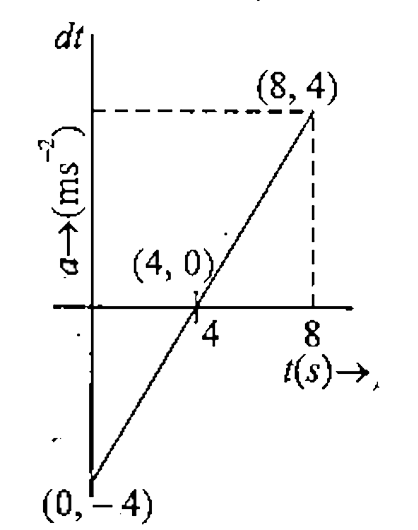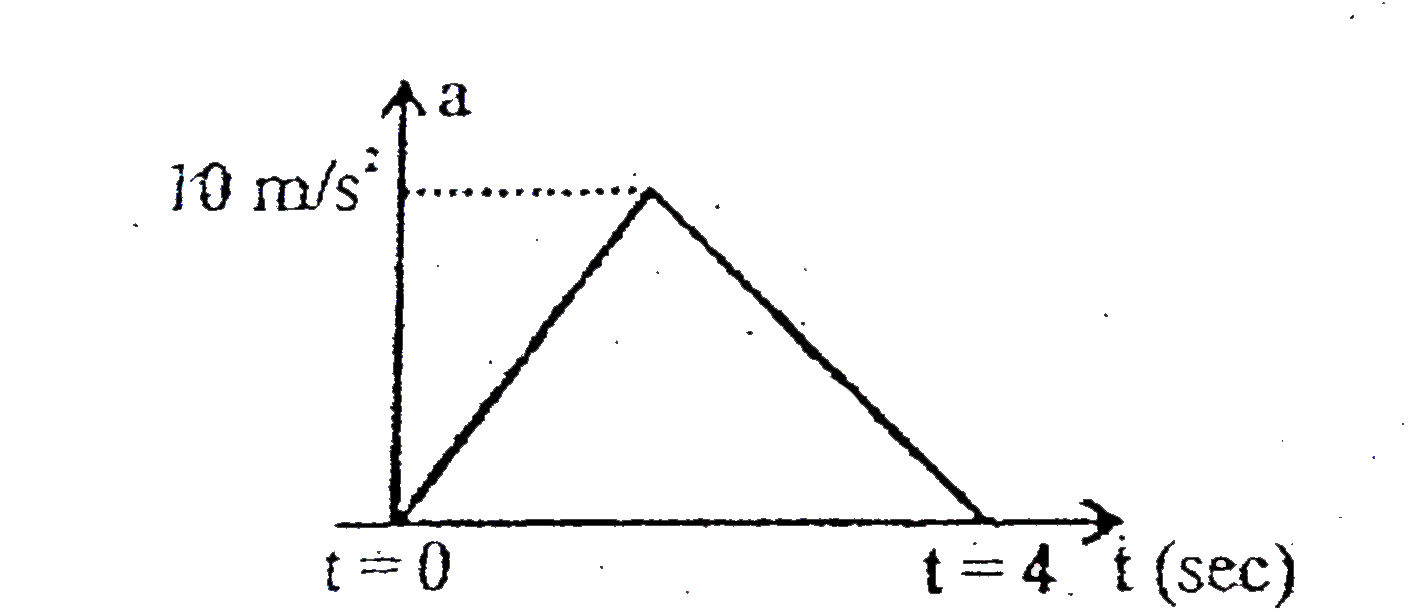At time t=0, a car moving along a straight line has a velocity of 16ms−1. It slows down with an acceleration of −0.5tms−2, where t is in second. Mark the correct statement (s).
The direction of velocity changes at t = 8s.
The distance travelled in 4 s is approximately 59 m.
The distance travelled by the particle in 10 s is 94 m.
The velocity at t=10sis9ms−1.
The correct Answer is:A, B, C
a,b,c. This is the example of non-uniform acceleration.
a=dvdt=−0.5t
∫v16dv=−∫t00.5tdt⇒16−0.5t22
Direction of velocity changes at the moment when it becomes zero momentarily.
0=16−0.5t22⇒t=8s
dxdt=v=16−0.5t2
Let us consider that at t=0, particle is at x =0
∫x0dx=∫t0(16−0.5t22),x=16t−0.5t6,
Distance travelled = |displacement for t≤8s. So, distance
travelled in 4s.
x=16×4−0.5×436=59m
Distance travelled in 10s.
=|Displacement∈8s|×2−Displacement∈10s
85.33×2−76.55=94m
v(t=10s)=−9ms−1.
Topper's Solved these Questions
- BOOK - CENGAGE PHYSICSCHAPTER - MISCELLANEOUS KINEMATICSEXERCISE - Linked Comprehension Type35videos
MISCELLANEOUS KINEMATICS
- BOOK - CENGAGE PHYSICSCHAPTER - MISCELLANEOUS KINEMATICSEXERCISE - Integer Type17videos
MISCELLANEOUS KINEMATICS
- BOOK - CENGAGE PHYSICSCHAPTER - MISCELLANEOUS KINEMATICSEXERCISE - Interger type3videos
MISCELLANEOUS KINEMATICS
- BOOK - CENGAGE PHYSICSCHAPTER - LINEAR AND ANGULAR SIMPLE HARMONIC MOTIONEXERCISE - Multiple Correct Answer Type9videos
LINEAR AND ANGULAR SIMPLE HARMONIC MOTION
- BOOK - CENGAGE PHYSICSCHAPTER - MISCELLANEOUS VOLUME 2EXERCISE - INTEGER_TYPE10videos
MISCELLANEOUS VOLUME 2
Similar Questions
A particle moving in a straight line has its velocit varying with time according to relation v=t2−6t+8(m/s) where t is in seconds. The CORRECT statement(s) about motion of this particle is/are:-
View SolutionA particle starts from rest at t=0 and moves along a straight line with a variable acceleration given by a (t)=(3t+1)ms−2 ,where t],[ is in seconds.The velocity of the particle at t=4s is
View Solution
Knowledge Check
- Question 1 - Select One
At time t=0 s a car passes a point with velocity of 16m/s and thereafter slows down with acceleration a=−0.5tm/s2 ,where t is in seconds. It stops at the instant t=
A32sB16sC8.0sD4.0s - Question 2 - Select One
If a particle is moving along a straight line and following is the graph showing acceleration varying with time then choose correct statement(s). At t=0,x=0 and v0=7ms−1
 AIts displacement can never become zeroBIts velocity can never become zeroCIts displacement can become zeroDIts velocity can become zero
AIts displacement can never become zeroBIts velocity can never become zeroCIts displacement can become zeroDIts velocity can become zero - Question 3 - Select One
Acceleration time graph of a particle moving along a straight line is given. Then average acceleration between t=0 & t=4 is :−
 A0m/s2B5m/s2C10m/s2D7.5m/s2
A0m/s2B5m/s2C10m/s2D7.5m/s2
The velocity function of an object moving along a straight line is given by v(t)=At2+Bt. If at t=2s, the velocity is 3 m/s and acceleration is 0.500m/s2, find the value of the constant A.
View SolutionA partile is moving along x−axis such that its position is given by x=4−9t+t33 where t is time in seconds, x is in meters, Mark the correct statement(s) :
View SolutionA particle moves along a straight line its velocity dipends on time as v=4t−t2. Then for first 5s:
View SolutionA car moves along a straight line whose equation of motion is given by
s=12t+3t2−2t3
where s is in metres and t is in seconds. The velocity of the car at start will be :-View SolutionIf a particle is moving along a straight line and following is the graph showing acceleration varying with time then choose the correct statement (s) for interval t = 0 to t = 8 sec, At t = 0, x = 0 and v0=7m/s
View Solution

